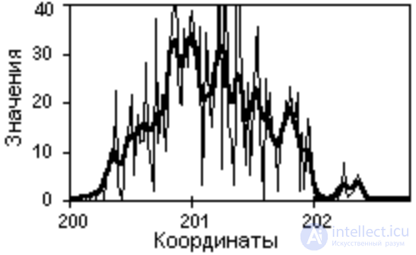Lecture
When detecting signals carrying information targeting this type of measurement, in addition to the main signal, interfering signals are simultaneously recorded - noises and interferences of a very different nature (Fig. 1.1.2). Interference also includes distortions of useful signals under the influence of various destabilizing factors on the measurement processes, such as, for example, the effect of micro-caverns in the borehole walls on measurements in X-ray radiometric logging methods, lightning discharges on electrical exploration methods, etc. Isolation of useful components from the total sum of registered signals or maximum suppression of noise and interference in an information signal while preserving its useful components is one of the main tasks of primary signal processing (observation results).

The types of interference are divided according to their sources of occurrence, according to the energy spectrum, according to the nature of the effect on the signal, according to probabilistic characteristics and other signs.
There are internal and external sources of interference.
Internal noises can be inherent in the physical nature of signal sources, such as thermal noises of electronic flows in electrical circuits or shot effects in electronic devices, or arise in measuring devices and signal transmission and processing systems from the influence of various destabilizing factors - temperature, high humidity, instability of power supplies, the influence of mechanical vibrations on galvanic connections, etc.
External noise sources can be of artificial or natural origin. Man-made sources of interference include industrial interference - motors, switches, signal generators of various shapes, etc. Natural sources of interference are lightning, fluctuations in magnetic fields, bursts of solar energy, etc.
Electric and magnetic fields of various sources of interference, due to the presence of inductive, capacitive and resistive connections, create parasitic potential differences and currents in various sections and circuits of signal systems, superimposed on useful signals.
Interference is subdivided into fluctuation, impulse and periodic. Fluctuation or noise interference is a chaotic and time-disordered process in the form of irregular random bursts of different amplitudes. As a rule, fluctuation noise is distributed according to the normal law with zero mean and has a significant effect only on low-level signals.
Pulse noise is in many ways similar to noise noise and is manifested both in the form of individual pulses and in the form of a sequence of pulses, the shape and parameters of which are random. The causes of impulse noise are sudden surges of current and voltage in industrial installations, vehicles, as well as natural electrical phenomena. Distribution of impulse noise is symmetric with an arbitrary distribution density.
Periodic interference is caused by periodic low-frequency or high-frequency fields of power lines, power installations, etc. If the main interference power is concentrated in certain parts of the frequency range, for example, at the frequency of the industrial network voltage or a multiple of this frequency, then such interference is called lumped.
Depending on the nature of the impact on the signal, interference is divided into additive and multiplicative. Additive (superimposed) interference is added to the signal, does not depend on its values and shape, and does not change the informative component of the signal itself. Multiplicative or deforming interference can change the shape of the information part of the signal, have a dependence on its values and on certain features in the signal, etc. With the known nature of the multiplicative noise, it is possible to correct the signal for their influence.
It should be noted that the division of signals into useful and interfering (noise) signals is rather arbitrary. Certain physical processes, phenomena or objects are also sources of interfering signals. When clarifying the nature of interfering signals, they can be transferred to the category of information. So, for example, well diameter variation is an interfering factor for almost all nuclear physics methods of logging. At the same time, the same factor, with the appropriate methodological and hardware support, can make it possible to contactless determination of the well diameter as an additional information parameter.
Comments
To leave a comment
Signal and linear systems theory
Terms: Signal and linear systems theory